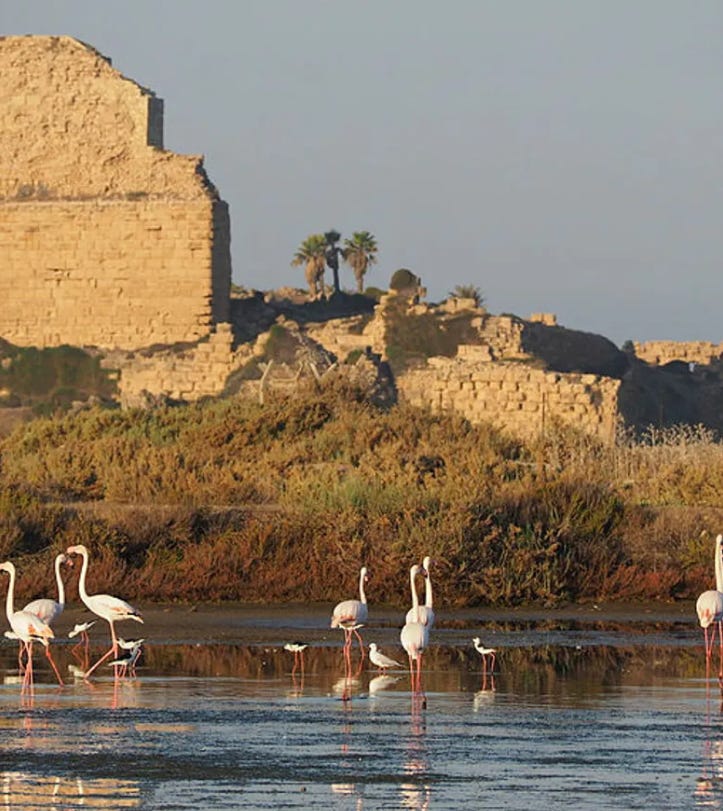Two Birds, One Drone
Let's start the new year off with an uplifting piece - the incredible story of Israel's avian superhighway
A few weeks ago, I was driving from my apartment in Haifa to visit some friends in Tel Aviv. But passing by the salt ponds next to Atlit I saw something that made me do a double-take. Were those… flamingos? I looked again and saw that yes, there was a flock of several dozen flamingos hanging out a 15 minute drive from where I lived!
Flamingos in Atlit in December, 2024 (Source: Lilia Kriv)
I wondered, were they someone’s pets? Did they escape from a zoo? There’s no chance that they’re wild, is there?
This experience led me down a rabbit hole of birding that I never thought I’d go down, and I discovered that the bird world of Israel is perhaps one of the most interesting and least talked stories of the country.
The Flamboyants are Coming
I learned that these flamingos were, in fact, wild! I also discovered that the largest breeding ground for flamingos in the eastern hemisphere are in western Iran and western Turkey.
However, the salt lake in Iran where the majority of the flamingos used to nest was dried up by government mismanagement of the water, and that the Iranian regime is allowing the salt and lithium to be mined by a Chinese lithium mining company. Meanwhile, the salt lakes where they breed in Turkey are slowly drying up due to water mismanagement by the government there.
Lake Urmia, the Largest Flamingo Breeding Ground in Iran, is Drying Up
All of this is leading these flamboyants of flamingos (yes, a flock of flamingos is called a “flamboyant”) to search for new breeding grounds. As a result, more and more of them have been discovering Israel and making their homes here - primarily in the salt ponds around Atlit and the Mt. Carmel area in the north, and Eilat in the south.
A Bird Superhighway
The flamingos are just one of the over 300 species of birds who are increasingly using Israel to migrate from north to south. The Levant (Israel, Lebanon, Syria, and Jordan) is the land bridge from Europe and Asia to Africa, and hundreds of millions of birds from as far away as The Baltics, Switzerland, and Ukraine use Israel to get from one end of the planet to the other every year.
Bird Migration Routes Between Europe and Africa (Source: France24)
As the surrounding countries have continued to dry up due to a combination of climate change, poor resource management, and unabated hunting, these birds are being forced through the only green, safe area in the region – Israel.
Bird and Man
What’s interesting about Israel is the fact that the government, as well as private organizations, are working hand in hand to protect the birds flying through the country on their way between Africa and Europe/Asia.
For instance, the Israel Ornithological Center, along with the Israel Nature & Parks Authority, work together with the Israeli Ministry of Energy and Infrastructure to determine where to build wind turbines so they don’t kill the birds. Kibbutzim in the Valley of the Springs and along the coast stock ponds with fish so that the birds coming through can fill up before heading onwards through the desert (and to stop the birds from eating the kibbutz’s own fish stocks). There are also heavy penalties for illegally hunting and killing these migratory birds.
Kibbutz Fish Farmer Feeds Migrating Storks (Source: Kan News)
In fact, because of the relative safety and comfort these birds have, more and more are simply staying in Israel, forgoing the treacherous trek to and from an increasingly drying Africa.
A Birdbrained Middle East
With so many unique species coming through a single bottleneck, Israeli and international researchers regularly capture and equip birds with tracking devices to see where they’re going as well as share notes with other countries to understand the health of the various flocks.
Usually these tracking devices are stamped with the organization the researcher is from, sometimes Tel Aviv University, sometimes Ben Gurion University, Hebrew University, etc. And sometimes they’re in Hebrew.
Vulture Captured in Lebanon and Accused of Being a Spy (Source: Viabintjbeil.org)
These birds fly through Arab countries, and this has caused some… issues. When people in these countries shoot the birds or capture them, they’ll sometimes see the Israeli tracking devices and believe the birds are actually spying for Israel! This has happened in Sudan, Lebanon, and even NATO member Turkey.
Another issue was that birds were being mistaken for drones. Before Israel destroyed the terror group, Hezbollah was sending surveillance and suicide drones over the border almost every day. However, the drones are about the same size as migratory storks, fly at about the same height, and look almost the exact same on radar.
This caused a huge issue in the beginning of the war whereby sirens would ring out in northern communities warning of massive drone swarms which turned out to just be flocks of storks. And in a few instances, Iron Dome missiles were launched and some of the storks were killed! Eventually the IDF solved the problem (to a certain extent).
The World Keeps Spinning
Here in the Middle East we’ve seen more than our fare share of wars, governments being toppled, rockets, bomb shelters, hostages being held by terrorists, and economic downturns. But the birds don’t care what we do.
They’re still flying back and forth across the planet. And it got me thinking about the bigger, global picture. As humans we think the world revolves around us. After all, we made the borders, we harnessed the power of the land to grow food for ourselves, created airplanes to travel the world within hours, and even managed to split the most fundamental building block of the universe – the atom.
And yet, we’re just one small part of this planet, sharing it with lots of other living beings that don’t really care about our territorial squabbles, our ideologies, or our religions. These creatures have their own problems to deal with (drought, a literal world war going on between ant colonies, fighting for food), and we humans are as much an afterthought to them as they are to us.
Wars start and end, empires rise and fall, and borders shift and dissolve. But still, the birds fly overhead.








